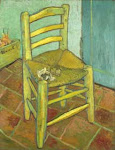
The summer of 1888, spent in Arles, was one of the most productive times of Vincent's career -- and one of the times when he was most happy. Harvest time in June resulted in a bevy of paintings and drawings, and even when the harvest was done, Vincent roamed the countryside around Arles looking for new subjects under the sun. He loved summer "like a cicada," he told his brother Theo, and the locals must have wondered at the foreign redhead painting for hours in the heat. It was the colors of the Provençal summer that inspired him: the rich golds and greens, bright flowers in a rainbow of hues...it's no wonder that the Arles paintings today tend to be the most popular among art lovers.
In July 1888, Vincent tried painting a new subject, one that he would intermittently return to for the rest of his time in Arles. The painting shown here depicts a corner of the public garden in the Place Lamartine, the square near the railway station where Vincent lived. (In July he was still living above the Café de la Gare, although already using the lower rooms of the Yellow House for studio space.) Scholars have even identified *which* corner: on this map, look for the sliver of park just north of where it says "Roubine du Roi canal." The entire square lay outside the medieval city walls and was part of the town's expansion around mid-century; according to Arles city records, the garden was planted in 1873. Vincent describes this painting to his sister: "I have also got a garden without flowers, that is to say a lawn, newly mown, bright green with the gray hay spread in long streaks. A weeping ash and a number of cedars and cypresses, the cedars yellowish and spherical in form, the cypresses rising high into the air, blue-green. At the back, oleander and a patch of green-blue sky. The blue shadows of the shrubs on the grass." (W5)
Vincent did another series of four paintings of the garden in the autumn, and a number of drawings spread over the time until he left Arles in May. He came to call this place "a poet's garden," associating it with the poetry of Petrarch and Boccaccio...love poetry. Is it a coincidence that just on the other side of the canal and the city wall lay the brothel district, the place Vincent called "la rue des bonnes petites femmes," the street of the good little women? Rachel's brothel, for instance, was located at the north end of the Rue du Bout d'Arles (marked on the map). Did Vincent somehow associate this lush garden with the women he met in the brothels? One can only speculate.
Unless one is writing fiction. In which case, you can make it so!






3 comments:
What is your opinion of that photograph purportedly found in the 1990s of Van Gogh?
I recently discovered it and just can't believe that it's him. It's a photo taken by a Quebecois photographer and it just doesn't add up despite its verification.
Love the painting and the story with it.
Hi Clever Pup: If I'm thinking of the same photograph you are, I'm with you and I don't think it's him. I mean, how many fellas had beards in the nineteenth century?? It could be anybody. At any rate, Vincent did not like photographs. I can't see him consciously posing for one.
Hi Mimi/Mom: Glad you like my post. You already know where that garden appears in the book!! Heehee...
Post a Comment